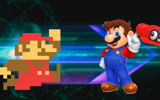Best Gaming Crypto Coins in 2024

As a committed gamer and an ever-curious crypto enthusiast, I've always been fascinated by the intersection of these two dynamic worlds. Where gaming meets cryptocurrency, there's an exciting, emerging sector known as 'crypto gaming.' And within this space, there are coins - crypto gaming coins to be specific. Now, you might be wondering what these crypto gaming coins are and why they are gaining so much attention. Well, let me tell you, these coins are more than just digital currencies; they represent a revolution in the gaming industry, fueling an immersive, decentralized gaming experience unlike anything we've seen before. So, gear up as I'm about to dive into the top 20 best crypto gaming coins that every gaming and crypto enthusiast should watch out for.
The Sandbox (SAND)

Description: The Sandbox, a virtual world and decentralized gaming platform built on blockchain technology. Empower users to create, own, and monetize their gaming experiences. Using the SAND token, you can participate in the virtual economy, buying and selling virtual assets, and contributing to the development of the platform.
Features:
- offer user-generated content creation.
- facilitate virtual real estate ownership.
- enable in-game asset monetization.
| Pros | Cons |
|---|---|
| Empowers content creators with full ownership rights over their creations | The value of SAND tokens can be highly volatile |
| Offers potential for high earnings through virtual real estate trading | Risks associated with digital property rights are not fully understood |
| Enables a new way to monetize gaming through in-game assets | Regulatory challenges and uncertainties around token-based economies |
Decentraland (MANA)

Description: Decentraland, a virtual reality platform running on the Ethereum blockchain. Enable users to create, explore, and trade in a fully decentralized virtual world. MANA, the native token, is used for transactions within the platform, including the purchase of virtual land and digital assets.
Features:
- provide user-owned virtual land.
- support decentralized governance.
- contribute to an in-world economy.
| Pros | Cons |
|---|---|
| Wide variety of unique user-generated content | Potential for inappropriate content due to lack of central moderation |
| Seize the chance to own and monetize virtual real estate | High entry cost for acquiring land and creating content |
| Ability to participate in virtual events, conferences, and experiences | Technical issues leading to a less smooth user experience |
| Collaborations with big-name artists and companies | A steep learning curve for new users |
Flow (FLOW)
Description: Flow, a blockchain designed for gaming and digital collectibles. They Provide a scalable and developer-friendly environment for decentralized applications. Enable the creation, trade, and ownership of non-fungible tokens (NFTs), making me a preferred platform for blockchain-based gaming and digital art.
Features:
- developer-friendly platform.
- support non-fungible tokens (NFTs).
- high-performance blockchain.
| Pros | Cons |
|---|---|
| Scalable architecture accommodating large user base | Limited adoption as it's relatively new to the market |
| Interoperable with other blockchains | Potential regulatory issues due to decentralised nature |
| Supports for developers to create decentralized apps | Competition from existing, more established platforms |
BEAM (BEAM)
Description: BEAM, a privacy-centric cryptocurrency based on the Mimblewimble protocol. Focus on enhancing transaction privacy and fungibility. Allow confidential transactions while maintaining a scalable and lightweight blockchain, making it an attractive option for users seeking privacy in their financial transactions.
Features:
- privacy-focused blockchain.
- enable confidential transactions.
- provide scalability improvements.
| Pros | Cons |
|---|---|
| Strong security measures | Lack of widespread adoption |
| Potential for high ROI | Regulatory concerns and market volatility |
| Increased user anonymity | High competition within the crypto gaming industry |
| Scalability for growth | Dependency on community for continued development |
Illuvium (ILV)
Description: Illuvium, a decentralized, community-driven blockchain game that merges blockchain technology, NFTs, and gaming. Players engage in play-to-earn mechanics, collecting and trading NFT-based characters. Decentralized governance system involves the community in decision-making processes.
Features:
- offer play-to-earn mechanics.
- provide NFT-based characters.
- support decentralized governance.
| Pros | Cons |
|---|---|
| Offers an immersive gaming experience with high-quality graphics | The initial investment can be high for players |
| Has a robust and promising roadmap | As a relatively new coin, its stability can be uncertain |
| Deflationary tokenomics can lead to an increase in value | The gaming industry can be highly competitive and unpredictable |
| Has clear use within the game, creating inherent value | Depends on the overall success of the game for sustainability |
Axie Infinity (AXS)

Description: Axie Infinity, a blockchain-based game where players collect, breed, and battle fantasy creatures called Axies. Operate on the Ethereum blockchain, and my native token, AXS, is used for governance, staking, and participating in the in-game economy.
Features:
- follow a play-to-earn model.
- provide NFT-based Axies.
- offer battle and breeding mechanics.
| Pros | Cons |
|---|---|
| High earning potential through in-game activities | Initial investment to start playing can be high |
| NFT-based Axies have potential resale values | Market volatility can affect the value of Axies |
| Battle and breeding mechanics add layers of strategy | Requires significant time commitment to achieve substantial earnings |
| Land ownership allows for passive income generation | Dependent on the continual popularity of the game for sustained returns |
Echelon Prime (PRIME)
Description: Echelon Prime, a blockchain project focused on decentralized finance (DeFi). They Provide various financial services, including staking, liquidity pools, and governance. The PRIME token plays a central role in the ecosystem, enabling users to participate in governance decisions and stake for rewards.
Features:
- offer DeFi protocols.
- provide staking and liquidity pools.
- support governance features.
| Pros | Cons |
|---|---|
| Echelon Prime enables wider user participation through its governance features. | The coin, because of being fairly new, may exhibit high volatility. |
| Offers opportunities for earnings through staking and liquidity pools. | Users need a certain level of blockchain understanding to fully utilize these features. |
| The integration of DeFi protocols lends to a promising future for the project. | These complex protocols may pose a steep learning curve for newcomers in crypto gaming. |
![]() Gala (GALA)
Gala (GALA)
Description: Gala, a blockchain platform that supports the creation and distribution of decentralized applications (DApps) and games. Feature a gaming ecosystem with an emphasis on NFT creation and trading. The GALA token is integral to my functionalities, including governance and transactions.
Features:
- provide a gaming ecosystem.
- support NFT creation and trading.
- built on a scalable blockchain.
| Pros | Cons |
|---|---|
| High potential for growth due to its gaming ecosystem | Relatively new in the market, thus less established |
| Pioneer in supporting NFT creation and trading within games | Dependent on the acceptance and adoption of NFTs |
| Built on a scalable blockchain, reducing issues of speed and congestion | Market volatility due to fluctuations in overall blockchain technology phase |
Ultra (UOS)
Description: Ultra, a blockchain-based platform for game distribution, offering new revenue streams for developers and enhanced gaming experiences for users. UOS, my native token, is used for transactions, in-game purchases, and participating in the platform's ecosystem, which includes a marketplace for virtual items.
Features:
- game distribution platform.
- offer an NFT marketplace.
- create a tokenized ecosystem.
| Pros | Cons |
|---|---|
| Ultra (UOS) delivers a user-friendly platform for both game developers and gamers, which can enhance gameplay and foster community engagement. | The coin's price can be highly volatile, presenting potential risks for investors. |
| It provides developers with new revenue streams beyond game sales, such as commissions on secondary market transactions. | The coin's success partly depends on the adoption and performance of the platform, which remains uncertain. |
| Ultra (UOS) aims to tokenize the gaming industry, potentially revolutionizing the way digital content is purchased, exchanged, and resold. | Regulatory uncertainties could potentially impact the coin's value and utility. |
| The platform's use of NFT sales could appeal to gamers seeking to make their digital assets more valuable and tradable. | Competition from other blockchain-based gaming platforms could limit Ultra's market share and growth potential. |
Guild of Guardians (GOG)
Description: Guild of Guardians, a blockchain-based, player-driven fantasy RPG where players earn rewards through gameplay and social interactions. Employ a play-to-earn model, with NFT-based items and characters. The concept of guilds and decentralized governance enhances the social and collaborative aspects of my game.
Features:
- offer a play-to-earn model.
- provide NFT-based items and characters.
- support guild-based gameplay.
| Pros | Cons |
|---|---|
| Guild of Guardians offers a strong community-oriented gaming experience. | The entry cost can be high, especially when buying higher-value NFTs. |
| Features attractive reward systems with its play-to-earn model. | Only players with significant time commitment can gain maximum returns. |
| Integrated with Ethereum blockchain which adds credibility and ensures transparency. | The game may be a little complex for beginners to grasp immediately. |
| The value of in-game assets can increase over time due to their NFT nature. | The game's economy is susceptible to market risks of the crypto world. |
Gods Unchained (GODS)

Description: Gods Unchained, a blockchain-based trading card game where players collect, trade, and battle with digital cards on the Ethereum blockchain. GODS tokens are used for transactions within the game, and the ownership of in-game assets is recorded on the blockchain, providing players with true ownership.
Features:
- provide tradable card assets.
- support decentralized ownership.
- offer competitive gameplay.
| Pros | Cons |
|---|---|
| Unique blockchain-based game mechanics. | Complexity of gameplay may deter casual gamers. |
| Playable cards are truly owned by players. | Strong dependency on Ethereum blockchain may cause transaction delays. |
| Ability to trade cards in an open marketplace. | High entry cost for competitive play. |
| Potential for high return on investment. | Crypto market volatility can impact in-game economy. |
Merit Circle (MC)
Description: Merit Circle, a blockchain project focusing on decentralized finance (DeFi) solutions and services. They offer various DeFi protocols, including staking and yield farming, with the MC token serving as a utility within the ecosystem. Community governance allows token holders to participate in decision-making.
Features:
- offer DeFi protocols.
- provide staking and yield farming.
- support community governance.
| Pros | Cons |
|---|---|
| Merit Circle is decentralized, offering individuals and groups the chance to participate in decision making. | As a new project, it may be more susceptible to volatile market conditions. |
| MC coins can provide staking rewards and opportunities for yield farming to maximize ROI. | Adoption rate and the prospect of staking rewards will depend heavily on the growth of the Merit Circle ecosystem. |
| Merit Circle aims to be an integral part of the crypto gaming industry, positioning MC coins for potential growth. | Success will rely on the overall acceptance and growth of the crypto gaming industry which is still emergent and uncertain. |
WAX (WAXP)
Description: WAX, a blockchain platform designed for the creation and trading of virtual items, with a focus on video games and entertainment. WAXP, my native token, is used for transactions and governance. The platform provides a user-friendly marketplace for buying, selling, and trading virtual items.
Features:
- offer a virtual item marketplace.
- support NFT creation and trading.
- provide a user-friendly platform.
| Pros | Cons |
|---|---|
| Low transaction fees. | Highly competitive market. |
| Fast transaction times. | Dependent on the success of the partner platforms. |
| Strong partner ecosystem (Hasbro, Capcom, etc.). | Cryptocurrency market volatility. |
| Large user base with high activity levels. | Regulatory uncertainties. |
| A leader in the blockchain gaming industry. | Limited mainstream adoption so far. |
STEPN (GMT)
Description: STEPN, a blockchain project integrating blockchain technology with social media and fitness, providing rewards for healthy lifestyles. They combine health and fitness tracking with social rewards, and the GMT token facilitates transactions and interactions within my ecosystem.
Features:
- provide health and fitness tracking.
- offer social rewards.
- integrate blockchain technology.
| Pros | Cons |
|---|---|
| Encourages physical activity through rewards system | Dependent on consistent user engagement for success |
| Integration of innovative blockchain technology | Might be technically challenging to understand for some users |
| Offers social rewards and incentives | Market competition from other fitness-based blockchain projects |
| Health and wellness tracking functionality | Privacy concerns associated with data sharing |
Mobox (MBOX)
Description: Mobox, a decentralized platform for blockchain-based games, offering a variety of gaming experiences and opportunities to earn rewards. They follow a play-to-earn model, with NFT-based assets and in-game economies, creating an ecosystem where players can engage and earn.
Features:
- offer a play-to-earn model.
- provide NFT-based assets.
- support in-game economies.
| Pros | Cons |
|---|---|
| Strong community support | High competition within the gaming coin market |
| High liquidity making it easy to trade | Price volatility, common in most cryptocurrencies |
| Effective play-to-earn model | Game adoption and longevity can impact coin value |
| Integration of NFTs for in-game assets | Development complications or delays can cause price drops |
Games For A Living (GFAL)
Description: Games For A Living, a blockchain project that integrates gaming with blockchain technology, allowing users to earn rewards while playing games. They employ a play-to-earn model, with NFT-based items and in-game rewards, creating an ecosystem where gamers are rewarded for their time and skill.
Features:
- provide a play-to-earn model.
- offer NFT-based items.
- provide in-game rewards.
| Pros | Cons |
|---|---|
| Games For A Living (GFAL) provides a unique play-to-earn model, allowing users to generate revenue while engaging in gameplay. | The coin’s value is highly dependent on the popularity and user base of the game, which can be unpredictable and volatile. |
| Offers the integration of NFT-based items, which can be bought, sold, or traded, providing another form of income for players. | The NFT-based items in the game could lose their value if the game loses popularity or ceases operation. |
| GFAL offers in-game rewards that can enhance the gaming experience and potentially yield real-world financial benefits. | Like with most Blockchain games, there are transaction costs associated with buying, selling, or trading in-game assets. |
Big Time (BIGTIME)
Description: Big Time, a blockchain project focusing on creating a decentralized ecosystem for gaming and digital collectibles. They aim to provide a platform where users can truly own their in-game assets through blockchain technology. The BIGTIME token is used for transactions and governance.
Features:
- contribute to a gaming ecosystem.
- provide an NFT marketplace.
- support decentralized ownership.
| Pros | Cons |
|---|---|
| Potential for high returns due to the growing popularity of crypto gaming coins | Price volatility is inherent to cryptocurrencies, leading to potential financial losses |
| Big Time (BIGTIME) has a unique selling proposition as a multiplayer action RPG built on Ethereum | The success of the coin is directly linked to the success of the game, which is uncertain |
| It gives users ownership of in-game assets through NFTs | Regulatory risks surrounding the use of NFTs and cryptocurrencies |
| Supports decentralized ownership and the freedom to trade in-game assets | Crypto gaming is still a developing industry and might not get mainstream adoption soon |
![]() MARBLEX (MBX)
MARBLEX (MBX)
Description: MARBLEX, a blockchain project that provides solutions for decentralized finance (DeFi) and blockchain-based financial services. They offer various DeFi protocols, including staking and yield farming. The MBX token is central to the platform, enabling users to participate in governance and earn rewards.
Features:
- offer DeFi protocols.
- provide staking and yield farming.
- support community governance.
| Pros | Cons |
|---|---|
| MarbleX (MBX) supports various utility offerings making it versatile. | Its value is highly volatile, posing financial risks to investors. |
| It's integrated into blockchain gaming, enhancing its practical use. | As an emerging coin, it may not be recognized or accepted universally. |
| MBX offers blockchain MRBLE NFTs, introducing unique assets into the market. | Crypto regulatory uncertainties may affect its growth and adoption. |
| It fosters an interactive and engaging community of players and investors. | The future of MBX largely depends on the overall success of MRBLE games. |
Oasys (OAS)
Description: Oasys, a blockchain project that aims to create a decentralized ecosystem for gaming, offering play-to-earn opportunities. They combine a play-to-earn model with NFT-based assets and in-game economies, providing users with a rewarding gaming experience.
Features:
- offer a play-to-earn model.
- provide NFT-based assets.
- support in-game economies.
| Pros | Cons |
|---|---|
| Notable partnership collaborations, enhancing its legitimacy. | Fairly new in the market, leading to less overall acceptance and awareness. |
| Potential for high return rates due to its direct integration with popular games. | The value of the coin is directly affected by the ongoing trends in the gaming industry. |
| Distributed governance offering users a say in the project's future. | As a decentralized platform, it could be a target for cyber security threats. |
| Enabled with the latest blockchain technology which ensures transparency and security. | Depends heavily on the performance and success of the linked games for its value. |
NFT Worlds (WRLD)
Description: NFT Worlds, a blockchain project focused on creating a decentralized metaverse where users can own, trade, and monetize virtual assets. They revolve around virtual real estate ownership, decentralized governance, and the creation and trading of NFT-based assets.
Features:
- facilitate virtual real estate ownership.
- support decentralized governance.
- enable NFT-based assets.
| Pros | Cons |
|---|---|
| Potential for high ROI given the increasing interest in NFTs and virtual worlds | High volatility as with most cryptocurrencies |
| Strong community support and development | Risk of regulatory measures impacting the NFT market |
| Provides digital real estate opportunities | Dependant on the continued popularity of NFTs and virtual experiences |
| Enables artists and creators to monetize their work on the blockchain | Limited adoption as compared to mainstream cryptocurrencies |
The Top 50 Best Crypto Coins for Gaming
- The Sandbox (SAND)
- Decentraland (MANA)
- Flow (FLOW)
- BEAM (BEAM)
- Illuvium (ILV)
- Axie Infinity (AXS)
- Echelon Prime (PRIME)
- Gala (GALA)
- Ultra (UOS)
- Guild of Guardians (GOG)
- Gods Unchained (GODS)
- Merit Circle (MC)
- WAX (WAXP)
- STEPN (GMT)
- Mobox (MBOX)
- Games For A Living (GFAL)
- Big Time (BIGTIME)
- MARBLEX (MBX)
- Oasys (OAS)
- NFT Worlds (WRLD)
- COMBO (COMBO)
- League of Kingdoms Arena (LOKA)
- Alien Worlds (TLM)
- Myria (MYRIA)
- Game.com (GTC)
- Small Love Potion (SLP)
- WAGMI GAMES (WAGMIGAMES)
- EPIK Prime (EPIK)
- Step App (FITFI)
- Bubblefong (BBF)
- Veloce (VEXT)
- IGUVERSE (IGU)
- Sweat Economy (SWEAT)
- Galactic Quadrant (GQ)
- GensoKishi Metaverse (MV)
- Rainmaker Games (RAIN)
- OrbCity (ORB)
- Rainbow Token (RBW)
- Walken (WLKN)
- ROCO FINANCE (ROCO)
- MetaTrace Governance Token (TRC)
- Caduceus (CMP)
- DEAPCoin (DEP)
- Katana Inu (KATA)
- DeFi Land (DFL)
- MagicCraft (MCRT)
- Netvrk (NTVRK)
- Shiryo-Inu (SHIRYOINU)
- Mundocrypto (MCT)
- Dotmoovs (MOOV)

Get $55 Stake Cash for Free








